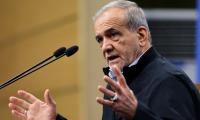Last week, whilst Pakistanis watched their prime minister try to explain his wealth to an investigative commission, the US made a major decision with dramatic policy implications for Pakistan. President Donald Trump announced that he was formally giving his authority to decide on American troop levels in Afghanistan to James Mattis, the Pentagon supremo who spent years helping manage the US war effort in Afghanistan, prior to his retirement.
Pakistan is still trying to recover from a history of American decisions with respect to Afghanistan. How far back we go depends on how old we are, and how much we respect experience. To contextualise Trump’s handing over of troop levels to Mattis, perhaps the best place to start is President Obama’s half-baked, weak-willed, lukewarm American “surge” announced at West Point on December 1, 2009. Many Pakistani democrats saw in that speech by Obama echoes and shadows of numerous elected Pakistani leaders – bruised, battered and defeated by the machinations of their generals, trying to put on a brave face while being humiliated and outmanoeuvred.
Obama’s 2009 surge of 30,000 troops doomed America’s Afghanistan mission by virtue of the absence of conviction behind it. His generals, particularly Stanley McChrystal, and many others that had come to occupy DC think-tanks across the political spectrum, had lobbied for far more. McChrystal himself had pushed for as many as 85,000, and some in the counter-insurgency community believed that without an extra quarter million troops inserted into Afghanistan, the US would not have a reasonable chance of wiping out the Taliban. Obama’s political people were mostly sceptical, with many of his bluest supporters strongly leaning toward a smaller training mission for US forces, and a quicker exit.
The 2009 surge was doomed not only because of the bickering and in-fighting curated by an indecisive and inexperienced president who seemed more keen to be fair to his dozens of advisers than he was to get his decisions right. The process leading up to the surge ended up costing McChrystal his job. But perhaps the most lethal element of the 2009 surge in Afghanistan was that it announced the withdrawal date for those troops: July 2011. Neither Obama nor the best advisers in the world could have known what 2011 would actually bring. To top it all off, the process leading up to the 2009 surge firmly enmeshed the topic of Pakistan as the whipping boy for America in Afghanistan. What would take place in 2011 – the year the surge was supposed to have been drawn back – had everything to do with Pakistan.
After the coalescing of the Tehreek-e-Taliban Pakistan in 2007, the Lal Masjid fiasco that same year, the assassination of Benazir Bhutto before the year end, and the eruption of suicide attacks across the country throughout 2008 and 2009, Pakistan first tried to tackle the TTP problem in Swat in the summer of 2009. The massive displacement of citizens that summer was followed by the devastating 2010 floods, a tragedy that directly affected over 20 million Pakistanis. Then came 2011. January brought with it the Raymond Davis incident, resulting in the easing out of the foreign minister at that time, Shah Mehmood Qureshi.
In May 2011, US Navy Seals attacked a compound in Abbottabad, killing Osama bin Laden. Pakistan then spent the entire summer in the virtual doghouse of the mainstream US media, followed by two events in September 2011 that soured the mood permanently. Former Afghan president Burhanuddin Rabbani was assassinated on September 20, and two days later, US chairman Joint Chiefs of Staff, Admiral Mike Mullen testified to a senate committee that he believed that the Haqqani Network, a designated terrorist group, was “a veritable arm of the Inter Services Intelligence”.
On November 26, 2011 US and Nato forces attacked a Pakistani post on the Pak-Afghan border. Twenty-five Pakistani soldiers were martyred in that attack. Having already virtually suspended relations with Afghanistan because of the-then president Karzai’s accusations that Pakistan was behind Rabbani’s assassination, the Salala attack essentially put the Pakistan-US relations on ice. Nato’s ground lines of communication were suspended, and US use of Pakistani air force ground assets was terminated. It took over seven months to repair the relationship (disclosure: I worked at the Ministry of Foreign Affairs during this period). On July 4, 2012, Hillary Clinton called the-then foreign minister Hina Rabbani Khar to tender a US apology to Pakistan for the Salala attack.
It has been five years since that reset in the relationship, and much has changed in Pakistan and the immediate neighbourhood. But three things remain the same. If Pakistan does not begin to pay more and better attention to the Afghanistan problem – a problem that is simultaneously its India, its America, its Russia, and possibly Turkey, Iran and China problem too – it risks reliving a nightmare that the country can ill-afford.
First, even though Karzai is long gone, the bitterness and distrust between Afghans and Pakistanis has remained. In fact, it has grown substantially over the last two years. Afghans have plenty to introspect about on this front, but Pakistan is a nuclear power with a population over six times the size of Afghanistan. If Afghan-Pakistan relations are broken, it is Pakistan that has the agency, the heft and the incentive to fix it. Instead, Pakistan has sought to punish Afghan business and, worse, Afghan refugees every time the volatile Ashraf Ghani decides to troll Pakistan. This pattern of allowing Afghans to dictate Pakistani moods and policies has produced a forty-year policy quicksand in Afghanistan.
Second, even though Pakistan-US relations are not the disaster they were in 2011, they are far from fully functional. Many important Americans on both sides of the political divide in the US consider Pakistan’s behaviour as that of an enemy. They blamed Pakistan for the need for a 2009 surge to begin with, they blame Pakistan for the continued conversation that Mattis will lead throughout June this year, and they will blame Pakistan for its inevitable failure before the year is over, if not sooner. The ‘do more’ and ‘blame Pakistan’ argument has always been and remains weak, with many holes. But it is also not entirely without merit, and never has been.
Third, India continues to be unrepentant about its role in Afghanistan. On the surface, this is understandable: Big Momma India helping out orphaned Afghanistan. In reality, India’s interest in Afghanistan is principally strategic and malign. Pakistanis are most likely correct to be paranoid about India in Afghanistan. But Pakistan’s responses to this threat have been self-effacing, at best: alienating Afghan refugees, and Afghan public opinion, demonising all Afghans as supportive of the TTP and allowing deliberate provocations by the Ghani-Modi combine to successfully trigger over the top reactions.
In this scenario, where so much of the core strategic problems are the same today as they were in 2009, no matter what decision James Mattis and the Pentagon make, or advise President Trump to take, they will find themselves in the same overarching sleeper hold that Obama, McChrystal, and later Petraeus dove into at West Point.
The added complexities today are manifold. Unlike in 2009, the Mullah Omar-less Taliban are fractured and relatively divided. Daesh has established more than a solid foothold beyond the Nangarhar province. Putin’s Russia is sniffing around for an opportunity to show up the Americans in an old US-Russia battlefield. Shia Iran is actively engaged with the Sunni Taliban. Qatar – home to the negotiations office of the Taliban – is in limbo. India is slowly but surely turning into a Hindu Rashtra with over one thousand years of existential anger fuelling it. And most of all, Pakistan is still wrought by the tensions between generals who don’t know their limits and politicians who won’t tell them.
Given the prime minister’s preoccupations and track record, and the military’s insatiable appetite for poor strategic decisions, it is unlikely that Pakistan is prepared for what is coming. This lack of preparedness is inexcusable.
The writer is an analyst and commentator.
Beijing was among first to denounce the tariffs, calling them “unjustifiable” and vowing strong countermeasures
With this unprecedented buildup, Diego Garcia has transformed into ticking time bomb of apocalyptic power
Pakistan is among world’s most climate-vulnerable nations, despite contributing minimally to global emissions
‘Azazeel’ is perhaps the most controversial novel to come out in Egypt this century
Dr Haroon Ahmed was an exceptional person, a precious human being who strived, throughout his long life
Pakistan can't afford another status quo budget so it must be budget of imagination, risk-taking and system-level...







